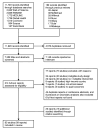WASH and learn: a scoping review of health, education and gender equity outcomes of school-based water, sanitation and hygiene in low-income and middle-income countries
- PMID: 40335077
- PMCID: PMC12056636
- DOI: 10.1136/bmjgh-2024-018059
WASH and learn: a scoping review of health, education and gender equity outcomes of school-based water, sanitation and hygiene in low-income and middle-income countries
Abstract
School-age children in low-income and middle-income countries (LMICs) face health and educational challenges due to inadequate water, sanitation and hygiene (WASH) in schools (WinS). Evidence for the impact of WinS interventions is limited and inconsistent, and previous systematic reviews have faced challenges in synthesising data due to varied interventions, study designs and outcome measures, although most do not examine this variability in more detail. This scoping review identified 83 experimental studies from 33 LMICs measuring a primary or secondary health or educational outcome among pupils, published up to November 2023, using a systematic search of seven databases and searching of reference lists of previous systematic reviews and included articles. These included 65 studies (78%) not included in previous WinS reviews and encompassed 313 intervention effects across 14 outcome domains. Interventions comprised an array of WASH technologies and approaches, often combining infrastructure and behaviour change methods and frequently integrated with other school-based initiatives like deworming. 36 studies (43%) measured only behavioural or knowledge outcomes. Our comprehensive inventory of study outcomes identified 158 unique outcome measures, with 72% measured in exactly one study. Common outcomes included parasitic infections, anthropometric measures and school absence, but approaches to measurement varied widely even for similar outcomes. Only 7% of results were disaggregated by gender, limiting assessment of differential impacts. Our findings underscore the need for standardised outcome measures in WinS research incorporating a complete definition of the assessment and aggregation approach, greater attention to gender-specific impacts, and further exploration of modalities and functions of WinS interventions alongside novel meta-analysis methods to disentangle effects of diverse intervention components.
Keywords: Child health; Environmental health; Epidemiology; Hygiene; Review.
© Author(s) (or their employer(s)) 2025. Re-use permitted under CC BY-NC. No commercial re-use. See rights and permissions. Published by BMJ Group.
Conflict of interest statement
Competing interests: None declared.
Figures





Similar articles
-
Interventions promoting uptake of water, sanitation and hygiene (WASH) technologies in low- and middle-income countries: An evidence and gap map of effectiveness studies.Campbell Syst Rev. 2021 Oct 8;17(4):e1194. doi: 10.1002/cl2.1194. eCollection 2021 Dec. Campbell Syst Rev. 2021. PMID: 36951806 Free PMC article.
-
Kenyan school book knowledge for water, sanitation, hygiene and health education interventions: Disconnect, integration or opportunities?Int J Hyg Environ Health. 2021 Jun;235:113756. doi: 10.1016/j.ijheh.2021.113756. Epub 2021 May 15. Int J Hyg Environ Health. 2021. PMID: 34004452 Free PMC article.
-
Impact of a school-based water, sanitation, and hygiene intervention on school absence, diarrhea, respiratory infection, and soil-transmitted helminths: results from the WASH HELPS cluster-randomized trial.J Glob Health. 2019 Dec;9(2):020402. doi: 10.7189/jogh.09.020402. J Glob Health. 2019. PMID: 31360445 Free PMC article. Clinical Trial.
-
Water, Sanitation and Hygiene (WASH) in Schools in Low-Income Countries: A Review of Evidence of Impact.Int J Environ Res Public Health. 2019 Jan 28;16(3):359. doi: 10.3390/ijerph16030359. Int J Environ Res Public Health. 2019. PMID: 30696023 Free PMC article.
-
Effectiveness of interventions for improving educational outcomes for people with disabilities in low- and middle-income countries: A systematic review.Campbell Syst Rev. 2025 Feb 6;21(1):e70016. doi: 10.1002/cl2.70016. eCollection 2025 Mar. Campbell Syst Rev. 2025. PMID: 39917627 Free PMC article. Review.
Cited by
-
Assessing Rural Communities in Central and East Africa: How to Provide Clean Water and Sanitation by 2030.Environ Health Insights. 2025 Jun 6;19:11786302251335130. doi: 10.1177/11786302251335130. eCollection 2025. Environ Health Insights. 2025. PMID: 40485756 Free PMC article.
References
-
- Evans DK, Mendez Acosta A, Yuan F. Girls’ Education at Scale. World Bank Res Obs. 2024;39:47–74.:28. doi: 10.1093/wbro/lkad002. - DOI
Publication types
MeSH terms
LinkOut - more resources
Full Text Sources
